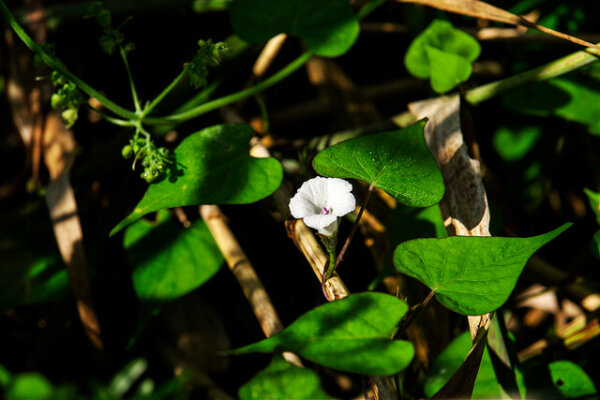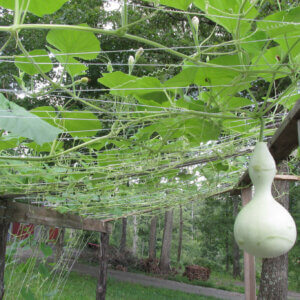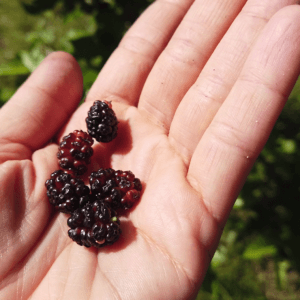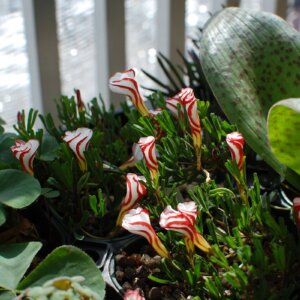Morning glory (Ipomoea lacunosa) is a flowering vine that is native to the eastern and southeastern United States. On the East Coast and in the South, it’s a well-loved and beautiful part of well-tended gardens.
But on the West Coast, it’s an invasive, pesky weed. When I moved into my new house, the yard was infested with morning glories.
Why Wild Morning Glory Is A Problem
Morning glory can, like other vine plants, choke out and kill the plants that you actually want to cultivate. It also grows very quickly; the plant’s creepers will take over an entire corner of your garden in just a few days.
When I moved into my house, morning glories had spread from our shared driveway, where everything grows wild, into an area of about 500 square feet in my garden. They would probably have spread over my entire yard if we hadn’t intervened.
How To Get Rid Of Morning Glory
The only way to eradicate morning glory—apart from herbicides, which we never recommend—is to make sure that none of the vines remain in your garden. That means you have to pull up every last vine of the stuff because it will come back quickly.

Getting rid of morning glory is a long-term project. You’ll need to fight several battles to get rid of the vine. The good news is that you can keep up on your morning glory eradication when you’re doing other garden chores, like deadheading, watering or trimming.
Before you start pulling, take a thorough look around your garden. Morning glory loves any vertical structure, so look over every side of a fence, lattice or hedge. Inspect any area where you’ve seen the vines from top to bottom.
The Tools For Eradication
All you’ll need to get rid of the morning glories in your garden is your gloves and a trowel. You also might want to wear a shirt with sleeves, because you’ll be going deep into the brush to get rid of their vines.
To kill a morning glory plant, you have to pull out the full vine. Trimming the vine from a plant it’s started to attack won’t do the trick: It will grow back quickly. To pull the vine, you’ll need to follow the vine back to its root and pull it from there.
The vines can get big. I’ve pulled morning glory vines that were more than 20 feet long. Be very gentle with the vine until you’re ready to pull the whole thing out; broken segments can quickly establish their own root systems.
Three Steps To Rid Your Garden Of Morning Glory
- When you find the root, gently disentangle the vine from the plant that it’s started to wind around.
- When you’ve successfully isolated the vine, let it rip. The broken vine will smell, oddly enough, like Pine Sol.
- Pull the whole thing out, and make sure that the whole root comes out with it. The vines can grow underground for a few feet, so make sure that you’ve dug to the original source of the plant.
And keep an eye on the area where you’ve pulled the morning glory vines. They will come back faster than you think: We pulled all the vines from the infested corner of our yard, only to have new vines start to bloom about a week later.
Morning glory is hardy and quick-growing, so eradicating it from your yard is a long-term project. It can be frustrating, but with persistence and vigilance, you’ll be able to easily get this pesky invader out of your yard.










































Persistence, vigilance and “easily” are not compatible concepts. There is nothing easy about the first two. Pulling the whole root is nearly impossible – especially in our dominantly clay soils, yes, here in the Pacific NW. What worked for us was regular mowing where they came up, cutting off their energy source (sunlight). Eventually they gave up. We never dug them up.
Our garden was left unchecked for 6 years. The Bind weed enjoyed our time off and gave us a battle. 1st, we dug up roots 8″ – 12″ – tilled the soil. 2 weeks later the weeds came back. Every weed killer I tried worked to kill the surface (label said product goes way down into the root). Ha! not true, the root system grew new sprouts and quadrupled (or more). In Calirado, (yes were halfway to being another California) we have clay, I have dug down past the conditioned soil and another foot into the clay to get at the “source” of the root. Some areas are 36″ below grade, what I’m trying to figure out is how much of the root will survive, what I mean is if a little 3/16″ x 1″ piece of root will survive to grow a new plant?
So we have taken some root pieces, soil and put them in a glass jar, the hope is broken pieces of root will not survive….
What was the result of your experiment?
Aaaaand?!? The world of morning ghastly is awaiting your reply.
Oh, the glory of Morning Glory! Into my fifth year living on the Oregon coast, and while my glories are regularly removed, my neighbors don’t care about theirs. Hence, a forever-til-the-day-I-die job. Ugh!! Just inherited the house across the street and – you guessed – Morning Glory!!! Dear Lord, will my aching back hold up?! I figure an hour per day until summer ends. Then I’ll keep watch.
For me it’s English Ivy and Blackberries. My neighbors like it across their back yards. Gotta fight it back every year, coming over the fence and under the soil.
There are many species of morning glories, many of which are invasive, while still others are more delicate, and desirable. White-star morning glory (Ipomoea lacunosa) is indeed bothersome. It produces more seeds than most species of ipomoea. Common Morning Glory, ipomoea purpurea, can be invasive, but generally is not. These are the kinds that you can buy from Lowes or Walmart. Star of Yelta, Milky Way, those types. They grow fast and big, but need more care to actually develop than I. Lacunosa, or I. Cordatotriloba. The most difficult to get to grow are of course the most beautiful of the species, Ipomoea Nil otherwise known as Japanese Morning Glories. Those are the most spectacular of all Morning Glories and almost never choke out any other plant. They are far more sensitive and delicate, but produce flowers from 2 inches to 6 inches in diameter of every color and shade including stripes and splits as well as mutations and other effects. I grow about 700 Japanese Morning Glories every year. They are by far the most beautiful diverse vining bloom I’ve ever seen.
I have been pulling up my morning glories for 10 years now. I read if you put poison on the leaves it will kill the whole plant. I am going to try some poison on a cotton ball and paint a few leaves to see what happens. My garden is too dense to do anything else. The one I have is so aggressive it is illegal to sell the seeds in the city. Wish me luck.
Is it working? The morning glories have been creeping into our yard from the neighbours
I moved to a small town in central Utah. For some reason the kids that owned the house thought that Morning glory, Foxtail and puncture weeds is what a lawn was made of. No grass!! I did water and that took care of the Johnson grass. I have managed to get rid of everything but the morning glory. I have tried every spray you can by or make. I have e en mixed them stronger than recommended but they still like on. I don’t really need anything to grow in my lawn because I’m going to do rock design. No grass. Any suggestions what to do? Is there anything? I’m not laying rock til next spring. I just don’t want to fight it coming up through the rocks. Thanks
Am I understanding you correctly? Watering your Johnson grass made it easier to eradicate?
Our garden has become infested with this !!!¡¡!! We are going to cover 7 of the 15 beds with black plastic. … Because tilling was a horrible idea and pulling will take a lifetime with all the tendrils off each root!!!! We have now named it “devil weed” lol
LOL I call it creeping death Theresa. I battled it all year last year, but is still choked out about half my garden. This year I am bleaching and salting the ever lovin heck out of it all, while leaving an appropriate area around my garden bleach and salt free. My neighbor did that last year, after battling for years, and he had no problems with it the entire season.
In early spring this year, I carefully pulled out every young bindweed plant. But as the summer wore on and temperatures reached the upper 90s and low 100s, I gave up and my garden was submerged in a sea of them. This morning, I began the excavation. Unfortunately, in the process, I’m sewing hundreds of seeds for next year, as it has already gone to seed, and pulling on the vines strips many off. I’ve been here before. The trick is to persist in keeping them pulled out before they mature and go to seed. Hopefully, I’ll do better next year with that!
I don’t even know from where this invasive vine came from… They are taking over my raspberry patch. As soon as I see them in the spring I try to pull them out from the roots but when the raspberry bushes start to grow it is very difficult to keep up with ripping out the vines. I have been battling them for 3 years now. I am tempted to relocate the raspberries. Perhaps next year when I retire I will have the time to address them. I really enjoy the raspberries.
My problem with morning glory is the same, it’s always winding itself around my raspberry canes. It is so hard to get rid of! I’ve been battling with it for at least five years. Right now it’s looking like it’s winning! I’m getting in there today to try to get rid of it…again!
Im going to cover my 20 by 50 ft raised bed garden with 6ml black plastic, for 2 years. Then start over. Been fighting this crap for 32 years, NO MAS. There is nothing that works on the market so save your $$.
Might honestly be the best move right here..
Up here in Canaderp. Bind weed is all over!! You can try and rip it out and be vigilant! But hey…. the neighbours don’t care, so it thrives! Drought has zero effect on it. If you rip it out, look again in 3 days!! Rip any new growth. I’ve now pulled 20 – 50 foot vines out! I will say this, of ANY species of plant, this one is quite amazing! -RB-
I just want to add, if you get a “hard to kill” species of them, and they cause problems for you in one area, but right next to that area, you keep mowed, the roots will live with the cut grass and keep pushing into your trouble area even if you pull every root out that area 100% for 10 yrs straight.. I truely dispise this plant. Best of luck yo everyone.. its been 3 years for me and I’m tired.